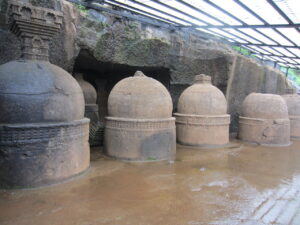
From the inception of Buddhism in the 6th century B.C.E., a core sacrament was being placed against idolatry. Even the veracity of it could be deduced from the sayings of Siddhartha Gautama Buddha, in his final act of didactic instruction to his favourite disciple, Ananda, to always remain against the notion of dependence of any kind; rather instructed him to become the light of yourself and take refuge in thyself.
The nature of this principle remained an obedient instruction. At least that is what one can infer through the literary sources, in accordance with the noticed absence in the rules governing the nature of idolatry in the daily behaviour of the monks in the Pali Vinaya Pitaka (an early text on the rules and regulations of the Buddhist Sangha). However, the dynamics on the aversion to idolatry was far removed in picture if the literary sources are to be conceded for archaeological evidence, pertaining in its view towards the establishment of the Caityagrihas, being dotted voraciously in the buddhist monasteries.
Acting as a significant part of the early buddhist religious landscape, these Caityagrihas remained as the main religious shrines of the sangha, in which the monks and nuns readily worshipped the monolithic edifices of the Caitya Stupa, symbolising the representation of the Buddha himself.
Many scholars have postulated this peculiar nature but none so far has provided a definitive answer to a puzzling question. Although some scholars hypothesise from a general point of view that any supernatural powers attributed to the natural phenomenon or a spiritual preceptor, gets manifested in the objects which the devotees worship as a dominant form of a religious identity basing all their reverence to that particular idol. The Buddha’s stūpa represents one such case while another is much more peculiar in nature. This extended peculiarity is enumerated through the addition of a new form of worshipping of the ‘cult of the monastic dead’, being first revealed in the Memorial Gallery located at Bhaja.
Situating itself on the low lying hills above the village of Bhaja, these memorial galleries were sculpted round the rock in cave no. 20 and has some of the the most exquisite and earliest known stūpas, which inhibit a fascinating transformation of worshipping of the departed theras (Teachers) along with the veneration being placed to the main shrine complex of Buddha stūpa in cave no. 12 at Bhaja.
The memorial gallery comprises a repository of 14 stūpas of considerably varying sizes,with each stūpa conforming to the basic style of a stūpa architecture in which the Adhiṣṭhāna Medhi (Bottom portion), Anda (Hemispherical portion), Harmika (upper rectangular portion) and the Chatravali (Umbrella) are prominently depicted. A hollowed out niche in stūpa no. 10, represents a relic box, in which the original relics of the buddhist thera were installed, to be viewed by the visitors. Thus the stūpas acted as a lithic reliquary for the departed souls.
One basic thread of similarity of the memorial stūpas are the railing patterns executed on the brim of their medhi. Meanwhile, the only stark difference in their execution are seen on the extant harmika and chattravali, which are either elaborately ornamented in the pattern of a inverted pyramidal harmika being joined to the main rock ceiling or are disjointed from harmika to the top from which a wooden rod may have been inserted through as chhattrayasti (Umbrella Post) to the circular decoration of chattravali on the walled ceiling.
The stūpas are divided, as per their positioning, into two divisions in which 9 of the stūpas are displayed on the front line while the other remaining 5 are located in the inner sanctuary of the cave. This, according to S. Nagaraju, a prominent archaeologist, is crucial for putting a chronological label for the excavation of the Thera stūpas, in which the stūpas located in the frontline were earlier in chronology than the ones at the back. Thus informing us about a series of transformation in the architectural style of the stūpa types and articulates towards the continuance in the practice of the thera worship in the buddhist sangha.
But how can one infer that the stūpas of the Memorial Gallery are dedicated in honour of the Buddhist theras?
A plausible answer can be inferred from the inscriptions at the base of the stūpas which mentions the names of the theras, as revealed in the case of the stūpa no. 6 alluding to the thera Bhayaṁta Saṁghadina, in stūpa no. 7 of thera Bhayaṁta Aṁpikiṇaka, of stūpa no. 8 of thera Bhayaṁta Dhamagiri and others in stūpa no. 9 and 11, which are unfortunately effaced over time.
Apart from the absence being shown in the Pali Vinaya Pitaka, the only textual referencing on the practice of thera worship is indicated through the evidence of the Udana version of the vinaya pitaka which is comparatively a later text. As per its saying goes, it recounts of the story of ‘Bahiya of the Bark Garment’ in which after having seen the dead body of the Arihanta Bahiya, the head monk directed the other Bhikkhus to cremate the body and build a stūpa for it, as a fellow monk of the buddhist sangha has died. This instructed directive indicates the funerary and ceremonial practice of burying the departed theras in votive stūpas, providing credence to the archaeological material supplemented with epigraphical records thus found.
At this juncture, the cardinal question on the nature of this derivation to the changing paradigm of buddha worship to thera worship still persists. Unfortunately in the light of the meagre literary references with only the existence of the physical stūpas, a gradual process of inception and establishment of ‘the cult of the monastic dead’ couldn’t be easily explained. However, the memorial gallery at Bhaja still remains as one of the oldest religious enigma, which highlights a popular localised practice differing from the textual functionality to the actual reality in the early phases of the Hinayana (theravadin) period of the 2nd century B.C.E to 1st century C.E.

